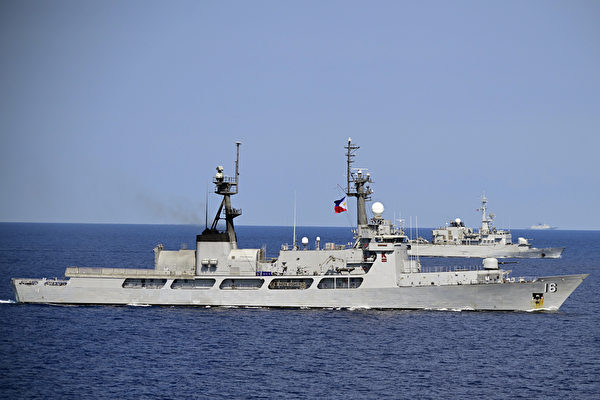On Monday, April 29th, the multilateral maritime exercise involving the United States, the Philippines, and France entered its fifth day, with both the US and the Philippines conducting live-fire exercises in the South China Sea. These joint exercises have drawn close attention from Beijing, as Chinese vessels such as the electronic reconnaissance ship “Uranus,” missile escort ship “Huangshan,” and missile destroyer “Shenzhen” have been monitoring the situation.
According to reports from the Central News Agency, the US, Philippines, and France began the multilateral maritime exercise (MME) on April 25th. France dispatched the frigate “Vendémiaire,” the Philippines deployed the landing platform dock “BRP Davao del Sur” and the offshore patrol vessel “BRP Ramon Alcaraz,” while the US sent the landing platform dock “USS Harpers Ferry” and the amphibious transport dock ship “USS Somerset” to participate in the exercise.
Central News Agency reporters boarded the BRP Davao del Sur to cover the 5-day maritime exercise involving the US, the Philippines, and France.
The US, Philippines, and French vessels conducted exercises in the Sulu Sea northeast of Palawan, Philippines, on April 25th and 26th before departing the Philippine waters on the 27th to engage in zone tactical maneuvers, cross-deck evolutions, and maritime search and rescue exercises in the South China Sea.
The Central News Agency reporters witnessed that the Chinese Navy’s electronic reconnaissance ship “Uranus” of the 815 type had been tailing the US and Filipino vessels at a distance of 3 to 6 nautical miles since around 6 a.m. on the 27th, keeping surveillance until dark, and it was still visible around 7 p.m., shadowing for at least 13 hours.
The next day, the Chinese Navy’s missile escort ship “Huangshan” bearing the hull number 570 appeared around 7:30 a.m. about 9 to 10 nautical miles from the Philippine vessel “BRP Davao del Sur,” “BRP Ramon Alcaraz,” and the French ship “Vendémiaire.” It stayed until around 1 p.m., and the “Uranus” showed up around 3 p.m., departing around 5:30 p.m.
On Monday, April 29th, the US and the Philippines conducted live-fire exercises in the South China Sea. The US ship “USS Somerset” fired at a large balloon target called “killer tomato,” followed by personnel from the Philippine vessel “BRP Davao del Sur” using onboard .50 caliber machine guns to shoot at the target, which was ultimately fired upon by the “BRP Ramon Alcaraz.”
The Chinese vessels “Uranus” and “Huangshan” began shadowing the US and Philippine vessels around 6 a.m. After the live-fire exercise commenced, the Chinese Navy’s missile destroyer “Shenzhen” with hull number 167 appeared around 9:45 a.m.; it was only until around 2:30 p.m. that the group of American, Filipino, and French ships moved approximately 30 to 35 nautical miles away from Palawan, with the three Chinese warships subsequently departing.
The Philippines and the United States are currently holding the three-week “Balikatan” joint military exercise involving over 16,800 American, Filipino, and Australian troops, with the participation of a French Navy frigate, making it the largest in years.
Tensions between the Philippines and China over territorial disputes in the South China Sea have been escalating. In this year’s military exercises, the Philippines and the US have, for the first time, joined with France for the multilateral maritime exercise. This marks the first expansion of the “Balikatan” exercise beyond Philippine waters, raising concerns about whether this move is in preparation for potential conflicts or incidents in the South China Sea.

